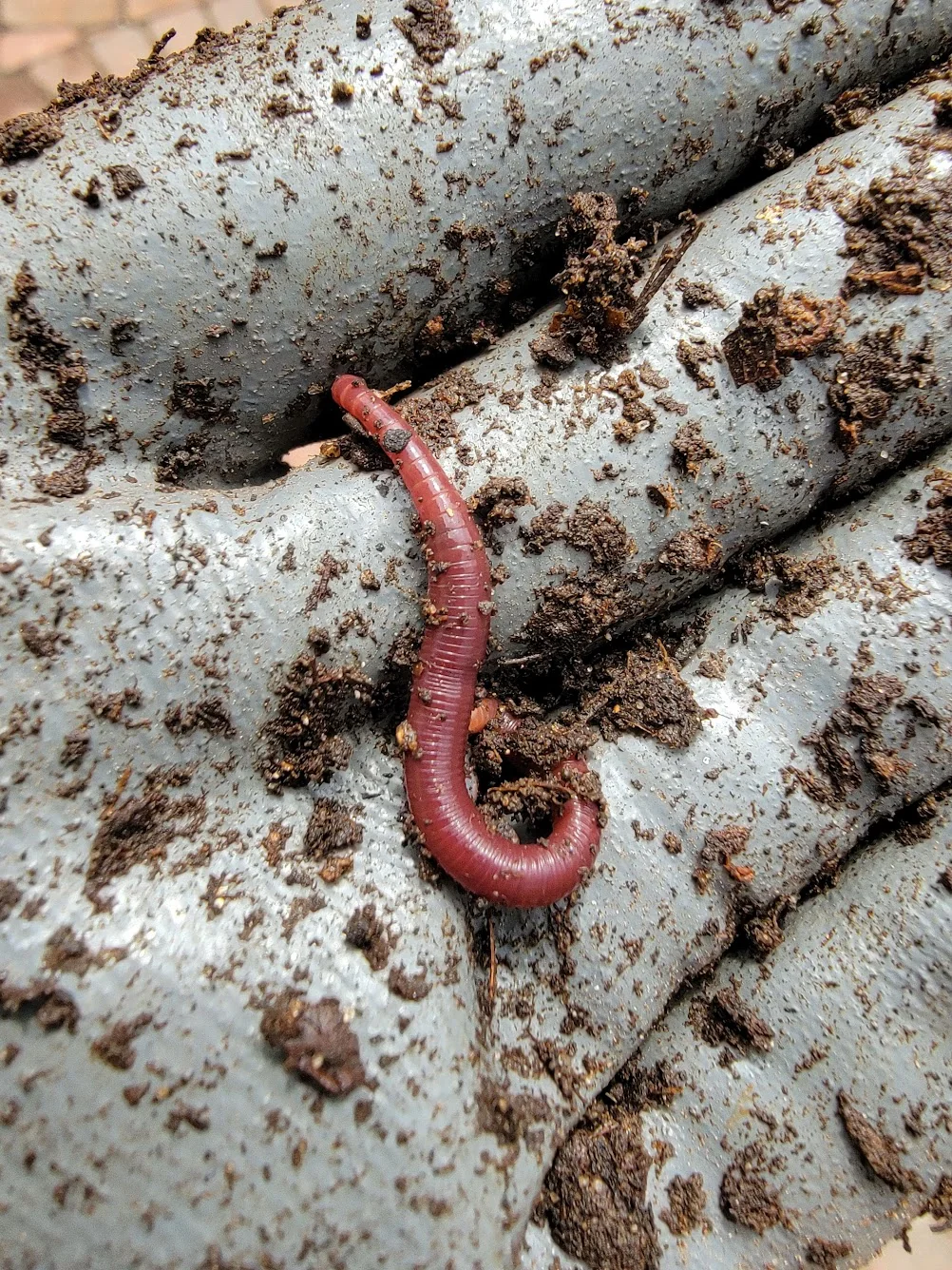
An invasive type of worm from Asia is posing a new challenge to Midwest gardeners. In gardens and yards, these jumping worms are wreaking havoc, so you need to take precautions to save your prized plants. Because they are tenacious and lack natural predators in the United States, these worms can proliferate quickly and cause destruction wherever they go.

The Asian jumping worms eat the soil, leaving it depleted and in bad condition. Their insatiable appetite modifies the structure of the soil, causing it to lose moisture retention and become depleted of nutrients. This makes the soil more susceptible to erosion, which further complicates the situation for plants trying to grow.
These worms may be really scary in addition to harming the soil. Despite the term suggesting they may “jump,” they move more like a twisted snap, which contributes to their unsettling appearance. Several states have acted to stop this dangerous invasion because they understand how important it is to handle this matter. Wisconsin, Missouri, Illinois, Iowa, Minnesota, Nebraska, Ohio, Texas, Louisiana, Indiana, Kansas, Kentucky, Tennessee, and Oklahoma are among the states that are impacted.
If you see these worms, you should get rid of them immediately to protect your garden. By stealing nutrients from the soil, these invasive worms deprive nearby plants and animals of their food supply. The local ecosystem deteriorates in the absence of a suitable habitat, which causes a decrease in the number of plants and animals.
There are steps you may take to fight these worms if you live in one of the impacted states. The University of Wisconsin-Madison Arboretum’s Brad Herrick, an ecologist, advises sprinkling a mixture on the ground to encourage the worms to come up for air and leave their underground homes. This technique can shield your garden from them and help lower their population.
A distinguishing feature of the Asian jumping worm’s body is a white ring that is situated near to its head. It’s best to get rid of these worms right away if you find them. Any mature worms you find should be disposed of after being placed in a plastic bag and left in the sun for at least 10 minutes. Furthermore, it’s crucial to avoid buying these worms for composting, gardening, or bait. Since their eggs cannot withstand temperatures higher than 104 degrees Fahrenheit, only purchase mulch or compost that has been thoroughly heated to reduce the chance of their spreading.
We can preserve the health and vibrancy of our ecosystems as well as our gardens by acting proactively to combat this invasive plant. By working together, we can end the jumping worm’s destructive reign and bring harmony back to our Midwest gardens. To find out more about these invasive worms and their effects, watch the video below:
My Marriage Ended after My Husband and I Attended Our First Graduation Party in 10 Years

Angelica’s seemingly perfect marriage unraveled at her high school reunion after an old friend revealed a shocking secret about her husband, Tom. Devastated, Angelica must now confront him and decide how to move forward with her life.
My name is Angelica, and I still remember the first time I met Tom in high school. From the start, everyone knew we were meant to be together. We both came from affluent families, living a life of comfort and privilege.

A happy couple | Source: Pexels
“We’re like a fairy tale,” Tom often said, smiling at me.
After college, we married and built a beautiful home together. We were blessed with two wonderful children, Emma and Jack. Our life was filled with family vacations, elegant dinners, and social gatherings.
“Our house feels like a dream,” I often told Tom. “I love our life.”

A luxury house | Source: Pexels
“Me too, Angelica,” Tom would reply. “We’re so lucky.”
Weekends were spent playing with the kids in our backyard, hosting BBQs for friends and family, and enjoying quiet evenings together. One Saturday, as we grilled burgers, Emma and Jack ran around playing tag. Tom looked at me and said, “I wouldn’t trade this for anything.”
“Neither would I,” I agreed, feeling content.

Grilling meat | Source: Pexels
To the outside world, we were the perfect couple. We rarely argued, always supported each other’s ambitions, and seemed to have everything one could wish for in a marriage.
Our friends often told us how lucky we were. They envied our love story, which seemed right out of a romantic movie. I often heard comments like, “You guys are the perfect couple,” and “I hope my marriage is as strong as yours.”
Then, one day, we received an invitation to our high school reunion. It had been ten years since we last saw our classmates, and we couldn’t wait to catch up with old friends.

An invitation | Source: Pexels
“Can you believe it’s been ten years?” Tom asked, looking at the invitation.
“It feels like yesterday,” I replied, excitement bubbling up. “It will be fun to see everyone again.”
We spent the next few weeks talking about the reunion, reminiscing about our high school days, and wondering what everyone else had been up to.
“Do you think Sarah will be there?” I asked Tom one evening.
“I hope so,” he said. “It would be great to see her again.”

A couple talking | Source: Pexels
The night of the reunion finally arrived. We walked into the venue, excitement buzzing in the air. The room was decorated with old photos and school colors. Laughter and chatter filled the space as we greeted old friends.
“Angelica! Tom!” someone called out. We turned to see Sarah, an old classmate from a humble background who had been close to us during our school years.
“Sarah! It’s so good to see you,” I said, hugging her tightly.
“I’ve missed you both,” Sarah replied, smiling warmly.

A smiling woman | Source: Pexels
As we caught up, Sarah showed us pictures of her children. “These are my pride and joy,” she said, her eyes shining with pride.
“They’re beautiful,” I said, smiling. “How old are they now?”
“Emily is eight, and Joshua is ten,” Sarah replied, beaming. “They keep me busy, that’s for sure.”
Tom looked at the photos and said, “You must be so proud, Sarah.”

Siblings playing | Source: Pexels
“I am,” she said, her voice filled with love. “They mean the world to me.”
As I looked closer at the photos, my heart skipped a beat. There, on the neck of Sarah’s eldest child, Joshua, was a distinct birthmark identical to the one my husband has. A wave of nausea washed over me. I blinked, hoping I was imagining things, but the birthmark remained. It was unmistakable.
Tom stepped away to catch up with his old buddies, leaving me alone with Sarah. My mind raced with thoughts. I tried to keep my composure, but I couldn’t shake the feeling that something was terribly wrong.

A serious shocked woman | Source: Pexels
“Sarah,” I began, my voice barely above a whisper, “can I ask you something?”
“Of course,” she replied, her eyes widening.
“That birthmark… on Joshua’s neck. It’s just like Tom’s. It’s quite a coincidence, isn’t it?” I said, trying to sound casual, but my heart was pounding in my chest.
Sarah looked at me, eyes filled with sorrow and regret. “Angelica, I can’t lie anymore. Back in high school, Tom and I… we had an affair. It was brief, and we both regretted it. But then I found out I was pregnant.”

A crying woman | Source: Pexels
I felt like the air had been sucked out of the room. “Pregnant?” I whispered, barely able to form the words.
Sarah nodded, tears brimming in her eyes. “Yes. When I told Tom, he was shocked. He didn’t know what to do, so he told his parents. They all decided it was best to keep it a secret. They offered me a large sum of money and agreed to provide informal child support until Joshua turned 18, in exchange for my silence. They didn’t want to lose you as a daughter-in-law, coming from such a noble and wealthy family.”

A woman deep in thought | Source: Pexels
I stared at her, trying to process what I was hearing. “So… Joshua is Tom’s son?” My voice trembled, and I felt a lump in my throat.
“Yes,” Sarah replied, her voice breaking. “I’m so sorry, Angelica. I didn’t want to hurt you. I thought this was the best way to handle it at the time. But living with this secret has been eating me up inside.”
I felt like the ground had been pulled out from under me. Tears streamed down my face as I struggled to comprehend the betrayal. Without another word, I stood up and walked away, my heart shattered.

A close-up shot of a crying woman | Source: Pexels
The shock and devastation hit me like a tidal wave. My mind was a whirlwind of emotions. Betrayal, anger, sadness, and confusion all swirled together. I started to cry, unable to contain the overwhelming pain. I knew I couldn’t stay at the reunion any longer. I needed to get away, to process everything that had just been revealed.
I hurried out of the venue and drove home in a daze. When I arrived, I didn’t say anything to Tom. I just started packing. Tom followed me into the bedroom, his face etched with concern.

A worried man | Source: Pexels
“Angelica, what’s wrong? Why are you packing?” he asked, his voice trembling.
I glared at him, the weight of the secret suffocating me. “Don’t you dare act clueless, Tom,” I snapped, tears welling up in my eyes. “I know everything.”
His face went pale. “What are you talking about?”
“You lied to me for years,” I shouted, my voice breaking. “Sarah told me everything.”
Tom’s eyes widened in panic. “Angelica, please, let me explain—”

A couple arguing | Source: Pexels
“No,” I cut him off, my voice firm. “I’m done listening to your lies.”
I gathered the children’s things and loaded them into the car. Emma and Jack looked at me with confused eyes, but I couldn’t find the words to explain. I just needed to get away, to find solace somewhere.
“Mommy, where are we going?” Emma asked, her voice small.
“We’re going to Grandma and Grandpa’s house,” I said, trying to keep my voice steady.

A woman driving at night | Source: Midjourney
Together with the children, I drove to my parents’ house in another city. The journey felt like a blur, my mind racing with thoughts of betrayal and heartbreak. When we arrived, my parents welcomed us with open arms, sensing that something was terribly wrong. I broke down and told them everything. They were shocked and devastated for me, but they offered unwavering support.
“We’re here for you, Angelica,” my mother said, holding me close. “Whatever you need, we’ll help you through this.”

A welcoming elderly lady | Source: Pexels
Over the next few days, I began to come to terms with the betrayal. The pain was still raw, but I knew I had to be strong for Emma and Jack. I started preparing for the divorce process. It wasn’t an easy decision, but I knew it was the right one. Tom’s betrayal had shattered the trust in our marriage, and there was no way to rebuild it.
My parents were my rock during this time. They helped me care for the children and offered emotional support. Their love and understanding gave me the strength I needed to move forward.

A happy elderly couple | Source: Pexels
As I prepared for the divorce, I felt a sense of resolve. This wasn’t the end for me; it was a new beginning. I was determined to move forward for the sake of my children and myself.
I found a lawyer and started the necessary paperwork. Each step in the process was painful, but it also felt like a step toward healing. I knew I had a long road ahead, but I was ready to face it.

Divorce papers | Source: Pexels
With the support of my family, I began to see a future beyond the betrayal. A future where I could find happiness and stability for myself and my children. I was preparing for a new chapter in my life, determined to move forward with resilience and hope.
This wasn’t the end of my story, but the beginning of a new one. One where I would emerge stronger, wiser, and ready to embrace whatever the future held.

A hopeful woman | Source: Pexels
This work is inspired by real events and people, but it has been fictionalized for creative purposes. Names, characters, and details have been changed to protect privacy and enhance the narrative. Any resemblance to actual persons, living or dead, or actual events is purely coincidental and not intended by the author.
The author and publisher make no claims to the accuracy of events or the portrayal of characters and are not liable for any misinterpretation. This story is provided “as is,” and any opinions expressed are those of the characters and do not reflect the views of the author or publisher.



Leave a Reply